Recent Commercial Posts
Does Your Business Have A Flood Plan?
9/20/2022 (Permalink)
 Despite the prevalence of floods, most businesses remain unprepared.
Despite the prevalence of floods, most businesses remain unprepared.
Business Have Unique Flood Preparedness Needs
A flood emergency preparedness plan will be quite different for a construction zone than an office building or industrial facility. Each site and industry suffers unique risks. Industry-specific resources are essential to planning success, as is staff training. A well-informed staff can prevent confusion and added risks to employees and property in the event of disaster.
The Most Basic Flood Evacuation Plan Should Include:
- The capacity for quick response.
With personnel in-charge of monitoring man-made possibilities, and an NOAA Weather Radio or other news resource for natural events. - A basic disaster supply kit.
This includes emergency and medical supplies, as well as enough food and water to last at least 72 hours. Preparedness training at work should likewise instruct employees on preparing their own mobile kit, for preparation to shelter-in-place for 24 hours in the event of emergency. - Plan development and training.
All employees should know what to do in an emergency, including disaster-specific evacuation and emergency response procedures. Assign specific employees (and backup personnel) to key tasks, such as emergency shut-down of equipment and power sources, and performing a roll-call. Exercises and drills to cement skills and uncover potential issues should be regularly performed, and flood and other emergency action plans reviewed and updated regularly. Clearly post and provide employees with paper copies of plans. - Emergency contact information.
Ensure all employees have a list of key telephone numbers. Blank business cards sheets from the local office supply are a convenient, easy way to provide a wallet-size list.
Reasons Why You Need Deep Office Cleaning Services
9/2/2022 (Permalink)
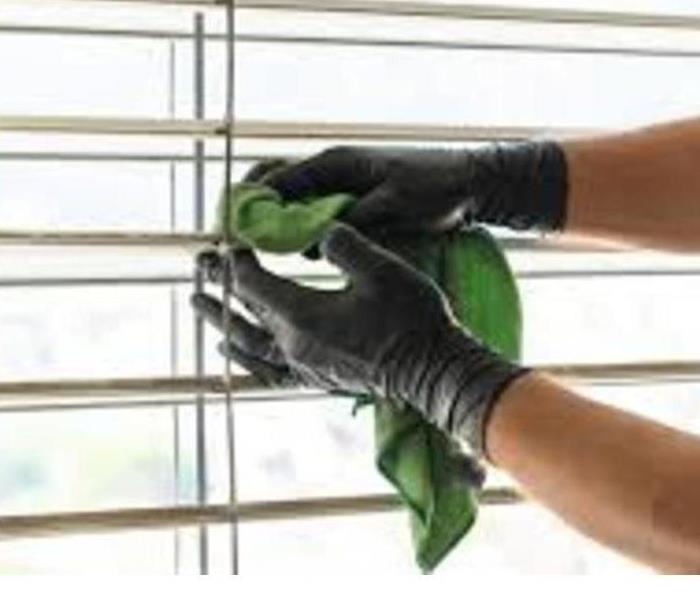 The benefits of deep office cleaning services go well beyond the elimination of germs and bacteria.
The benefits of deep office cleaning services go well beyond the elimination of germs and bacteria.
Office Sanitation Services: Reasons to Invest in Office Deep Cleaning Services
- Healtheir and Safer Employees
When it comes to office sanitation, there's not a benefit more important than the health and welfare of your employees. Eliminating hidden germs and bacteria is one of the easiest ways to stop the spread of viruses or bugs around the workplace. While your office may look clean, some workplace equipment is 400-times dirtier than the average toilet seat. Deep cleaning hard surfaces can make a big difference in your employees' health.
- More Productive Employees
Naturally, a clean office reduces employee sick days. Several studies over the years have shown that sick workers cost U.S. employers $2 billion annually. Spending money now on office deep cleaning services can have a great return on investment (ROI).
- Everything Looks Brand New
Something is gratifying about shiny new things. Research shows that the human brain is hardwired to be attracted to novelty. So, even if it's the same old office you've worked in for more than a decade, a deep clean can give it a like-new facelift, and it can give your employees a sense of fresh surroundings.
- Encourages Cleaner Individuals
Call it peer pressure, but if the tone is set early on that you run a clean office, expect your employees to follow suit. Many offices have general guidelines for employees to keep their workspace clean but expect that to be even more ingrained when they know their company is investing in a clean environment for them. This means providing things like anti-bacterial wipes and keyboard cleaner, but those are small costs that reap company-wide benefits when it comes to morale.
- Increased Pride in the Office
You don't have to research too hard to understand positive work cultures result in more productive employees. A regularly deep-cleaned office can be a point of pride that employees recognize. When employees are proud of their office, engagement increases, there's more creativity and they feel their work-life balance is improved. Simply put, they're more excited to come into the office.
- Easier to Recruit Employees
The best and brightest job candidates want to know their prospective employer cares about their health and safety and the office's overall vibe. If a candidate notices stained carpets, dingy grout or off smells they might be inclined to seek work elsewhere.
- Discover Unknown Issues
You never know what hidden sanitation or health problems a deep-cleaning crew could discover while on the job. Where are those water stains coming from? Why is there a smell permeating from the vents? These are just a few issues a deep cleaning team could uncover for you
FACTS ABOUT COMMERCIAL WATER DAMAGE
8/5/2022 (Permalink)
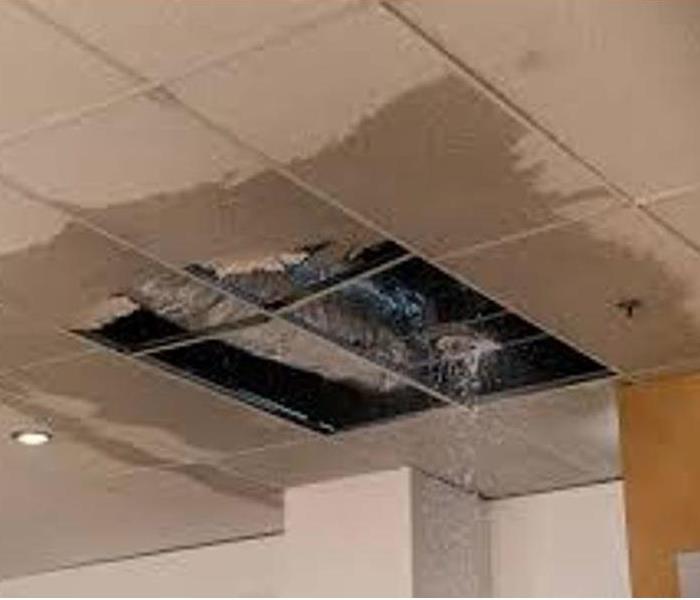 Buildings are the biggest asset for every business owner; discovering structural damage of any type will surely be stressful.
Buildings are the biggest asset for every business owner; discovering structural damage of any type will surely be stressful.
Every commercial building is different, but each is at risk for water damage. Even a minor roof or pipe leak can lead to unwanted water intrusion and negatively impact the value of your property. Here are some water damage facts every business owner needs to know:
1. PREVENTATIVE MAINTENANCE MAY STOP WATER DAMAGE ACCIDENTS
Get into the habit of inspecting certain elements throughout your building on a regular basis. Commercial water damage preventative maintenance tasks can include inspecting gutters, the roof, plumbing lines and drains. If necessary, have an expert inspect your building once or twice a year to help ensure everything is in proper condition.
2. ROOF LEAKS ARE A COMMON SOURCE OF COMMERCIAL WATER DAMAGE
Just a small roof leak can cause major havoc on a commercial building. Even if your roof is in excellent condition, the likelihood of a roof leak is prevalent in areas where severe wind, freezing temperatures and hail are frequent.
3. EVEN MINOR EXISTING LEAKS CAN LEAD TO MAJOR PROBLEMS
If left unchecked, minor plumbing malfunctions can cause extensive water damage. If you don't properly maintain your plumbing, your insurance company may not cover the costs associated with normal wear and tear.
4. THERE ARE DIFFERENT TYPES OF WATER CONTAMINATION
There are three different types of water contamination: white water, gray water and black water. The proper clean-up and safety procedures associated with commercial water damage vary depending on the type of water contamination. For that reason, it’s best to leave the water extraction, clean-up and restoration SERVPRO of Kendall County.
5. YOUR INSURANCE MAY NOT COVER ALL TYPES OF WATER DAMAGE
Some insurance policies cover sudden water damage, but there may be certain exclusions that apply. Typically, a standard insurance policy does not cover flood damage at all. For that reason, it's a good idea to familiarize yourself with your specific policy to make sure you have ample protection.
6. YOU MAY NEED TO PURCHASE A SEPARATE FLOOD INSURANCE POLICY
There are different insurance policies for water and flood damage. If you live in an area prone to flooding, you may need to purchase a standalone flood insurance policy. Contact your insurance agent to determine if you need additional coverage.
7. IF WATER DAMAGE OCCURS, CONTACT YOUR INSURANCE COMPANY IMMEDIATELY
Once commercial water damage happens, call your insurance company right away so your insurance agent can begin filing a claim. The company may be able to guide you through the initial steps you'll need to take to keep your property protected, too.
8. TIMELINESS IS A NECESSITY
When water damage threatens your property, knowing how to handle the situation within a timely manner can make a tremendous difference. If you know the basics of what to do once it happens, you can help prevent further damage.
9. EXTRACTION IS THE BEST APPROACH TO MITIGATING WATER DAMAGE
If not taken care of immediately, excess water can lead to costly damage to your building's structure. An experienced restoration company like SERVPRO of Kendall County understands how to reduce the amount of water damage that happens after a major leak, flood or other problem occurs.
10. PROBLEMS MAY NOT END WHEN THE WATER IS GONE
Even after water is removed, moisture can hide in walls and underneath floors, eventually leading to mold growth. It's important to have a mold prevention specialist inspect your building to ensure mold isn’t growing or spreading through your property.
4 Reasons You Need Professional Air Duct Cleaning for Your Office
8/3/2022 (Permalink)
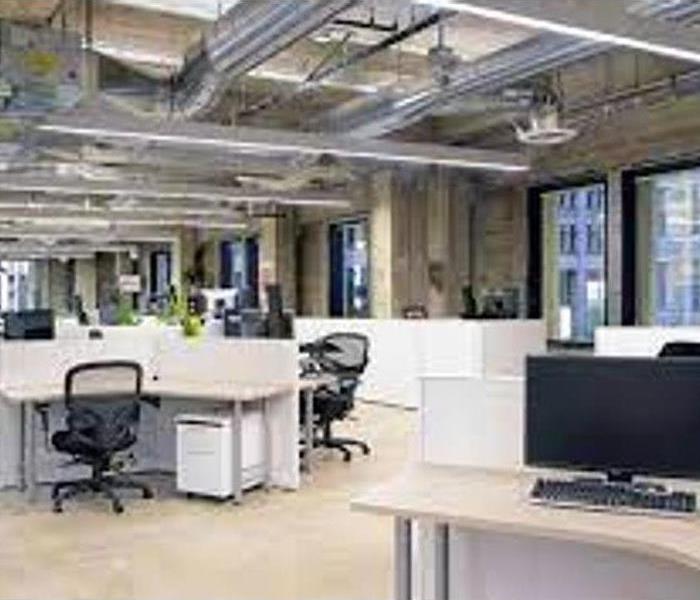 By ensuring that your air ducts remain clean, you can increase the productivity of your workplace.
By ensuring that your air ducts remain clean, you can increase the productivity of your workplace.
Mold Growth
– Visible mold growth in or around your HVAC air duct system should be a red flag. It is time to take action to avoid a potentially hazardous situation. To verify what you suspect is mold, the substances should be professionally tested. Mold issues with your air ducts are a real possibility especially if your HVAC system is located in the basement or attic. These areas are prone to high humidity and dampness; an environment in which mold can thrive. The combined effort of professional air duct cleaning along with removing the moisture source will drastically reduce the threat and potential hazards of mold.
Vermin
– You likely don’t want to think about it, but there is a good chance that rodents or insects have been traveling through your air ducts. These dark, secluded and sheltered areas make a perfect safe haven for certain critters. Many vermin carry unwanted bacteria that you just do not want spreading in your home or office. Periodic cleaning of the air duct system removes unwelcome guests and the mess they leave behind.
Excessive Dust and Debris
– Over time dust and debris can build up in your HVAC system. These contaminants can clog areas of your system or even be released into the home through supply registers. Dust and debris can accumulate faster if you have pets or have gone through a home renovation. Routine cleaning will help with reducing accumulated dust and potentially improve the indoor air quality of the property.
Efficiency
– Everyone is very conscious about home efficiency, especially when it comes to their utilities. Cleaning your air ducts on a routine basis plays a part in maintaining a HVAC system’s efficiency. A smooth running HVAC system is all about having strong air flow. Air flow can be hindered if ducts, coils, fans and motors are inhibited by dirt and debris. Eliminate this issue with professional air duct cleaning.
How to Improve Indoor Air Quality in a Commercial Building
8/2/2022 (Permalink)
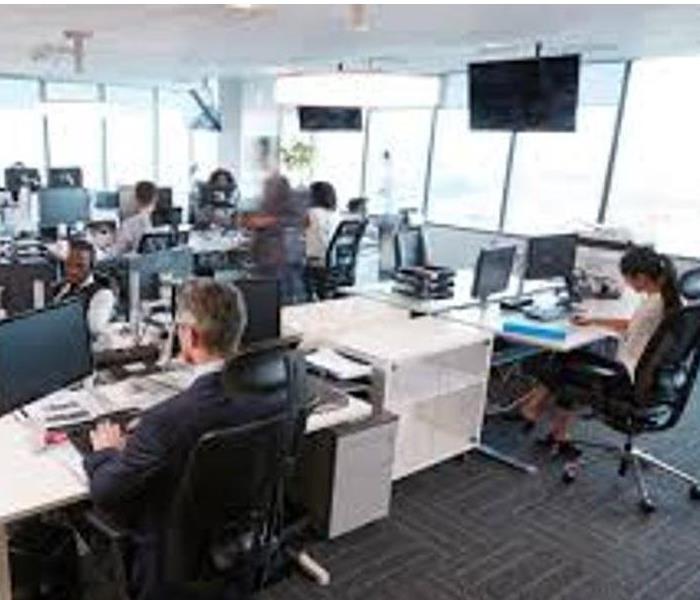 Keeping your employees safe and healthy in the workplace is important.
Keeping your employees safe and healthy in the workplace is important.
Keeping your employees safe and healthy in the workplace is important. After all, as a business owner, your employees are one of your most valuable assets. But when talking about creating healthy habits in the workplace, improving the quality of the air indoors is rarely mentioned.
Considering that breathing is something we do all day, every day, it’s important that the air we’re breathing is clean and fresh. But according to the Environmental Protection Agency, the air inside the average building is roughly five times more polluted than the air outside. This means you and your employees are likely subjected to indoor air pollutants, which can lead to health ailments (and sick days!) Fortunately, there are ways you can put an end to poor indoor air quality, like these three tips below.
1. Stop Indoor Air Pollutants at the Source
When it comes to indoor air quality, prevention is key. Poor conditions contribute to poor indoor air quality in the workplace, like leaky roofs and air conditioning system malfunctions (think improper cleaning, poor maintenance and the like). These conditions can lead to an influx of dander, dirt, dust, mold and other potentially harmful indoor air pollutants. While there are numerous ways to decrease these pollutants, prevention should be emphasized. Preventive efforts can be made in lots of ways. For example, always opt for all natural products, such as vinegar-based cleaning detergents. If you can, choose EPA recommended and indoor air quality safe products that are non-toxic.
2. Learn and Educate Yourself About Indoor Air Quality
Indoor air pollution is a big concern, yet many business owners and their employees know little about what it is or how it could potentially affect them. Long-term exposure to indoor air pollutants has been linked to numerous illnesses, including serious illnesses like respiratory disease and certain cancers. Because indoor air quality is so important, education is crucial. As a business owner, it’s a good idea to take the initiative to learn about indoor air pollutants and how you can improve the quality of the air you and your employees breathe. Take a more comprehensive look at indoor air quality.
3. Invest in Indoor Air Quality Solutions
When it comes to improving the quality of the air you breathe, a few small investments can make all the difference. Investing in a dehumidifier, for example, can remove up to 90 pints of excess moisture per day, which will help provide natural ventilation and improve the quality of the air inside. Another great option is installing a UV-C light system, which uses ultraviolet light to destroy volatile organic compounds from your commercial building.
Is Your Business Up-to-date With Current Fire Code
7/5/2022 (Permalink)
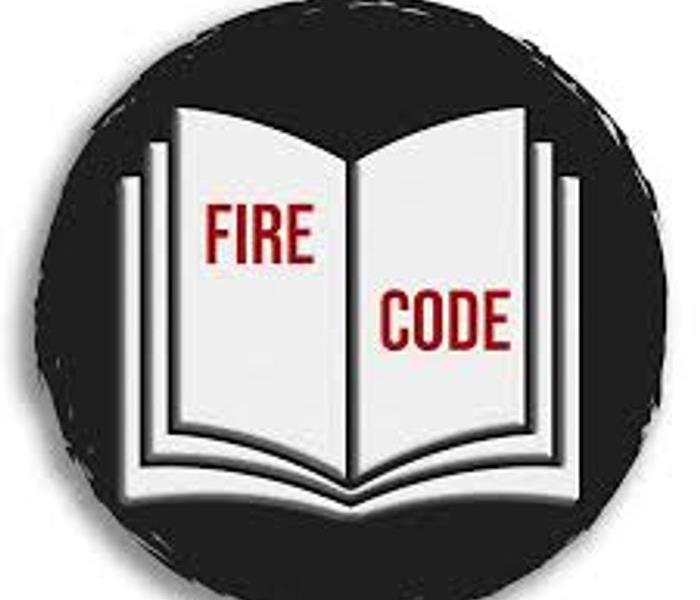 Every community has fire codes that, by law, all local businesses must follow.
Every community has fire codes that, by law, all local businesses must follow.
Experts estimate that 60 to 80 percent of all businesses never recover after experiencing a structural fire. Sadly, they fail for a lot of different but understandable reasons. Employees find new jobs. Customers locate services and products elsewhere. Critical records are lost. Suppliers move on. Given these challenges, it’s prudent to protect your business by reducing fire hazards in the workplace. One of the best ways to do so is ensuring compliance with current fire codes.
Every community has fire codes that, by law, all local businesses must follow. Promulgated by consensus groups – code and local officials, manufacturers, fire protection experts, industry representatives – these codes, which contain common standards as well as ones specific to individual municipalities, provide abundant benefits for communities. They create safer working environments, safer buildings for visitors, job security (job loss occurs when companies close after fires), social stability (burned structures create eyesores and security risks), higher property values and economic benefits (insurance carriers may offer lower premiums) among them.
Because these standards support healthy communities, officials regularly revise fire codes and inspect businesses, usually annually, to certify compliance. Unfortunately, businesses often fail to update their prevention measures when codes change. Common violations that inspectors see following code updates include:
- Sprinklers have not been installed in buildings where they are now required.
- Manual fire alarms have not been installed where they are now required.
- Fire egress routes are not maintained as required.
- Signage has not been updated as required.
- Fire prevention equipment – sprinklers, fire department hook-ups, extinguishers, fire alarm systems and smoke alarm systems – isn’t inspected and maintained as required.
- Fire prevention equipment has not been updated to comply with structural changes to the business.
Add these new violations to those that inspectors are used to seeing regularly – blocked exits, propped open fire doors, items hanging from sprinkler heads and dark exit signs – and the property quickly becomes unsafe.
The best way to ensure your business complies with the latest version of the local fire code? First, ask your company’s safety officer – regardless of size, every company should designate a safety officer – to inspect the property for fire hazards. Next, call the local fire department and request a voluntary inspection. These local professionals point out deficiencies ahead of the official inspector, who could levy fines for code violations.
Causes Of Commercial Water Damage & How To Handle It
4/5/2022 (Permalink)
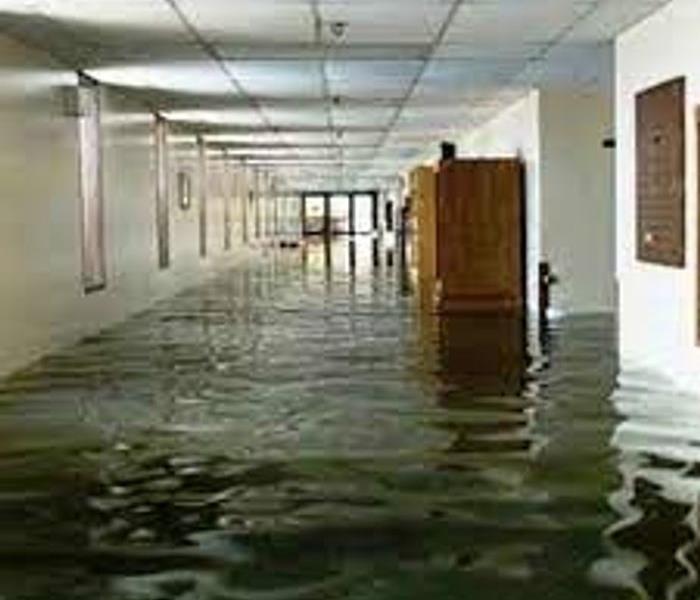 Commercial water damage restoration is always more multifaceted, detailed and demanding than residential water damage restoration.
Commercial water damage restoration is always more multifaceted, detailed and demanding than residential water damage restoration.
Water damage in the office can not only stop work as you know it… it can also put you and your co-workers in danger. The minute you detect indications of commercial water damage, it’s essential to take action immediately.
Commercial water damage restoration is always more multifaceted, detailed and demanding than residential water damage restoration. This is because commercial properties have to take into account several tenants, as well as areas and configurations– and there’s the added pressure of timeliness since tenants want to get back to business quickly.
Whereas several water damage issues are predictable, extra difficulties can be avoided once the cause of water damage is established. In this article, we’ll discuss the most usual causes of water damage in commercial properties and how to deal with them. Here’s what you should know…
1. Damaged pipes
Cracked pipes can stem from plenty of causes, like deviations in pressure, degraded water supply lines and sewer sanitation clogs. Freezing temperatures can cause pipes to rupture. Bloated barriers, water marks on walls or floors, broken or unattached shingles, and mildew odor are all indications of damaged pipes. Identifying dripping pipes is not always an easy task– it typically requires several tools and a bit of time to find the problem area(s).
2. Roof drips
A dripping roof can cause ceiling destruction, mold or decay matters, fire dangers from shortened wires, and compromised structural reliability. Heavy rains and snow make roofs susceptible to destruction. Improper snow/ice elimination can also generate water damage in roofs.
3. Pooling at the base
If channels are not gutted frequently, they can get congested, causing water to outflow into the property through the roof or at the base. One of the most typical indications of leaks of this sort are pools of water adjoining or surrounding the base of the building. Poor sewer structures can also result in water damage at your base.
4. HVAC issues
HVAC structures function by heating or cooling the air via a sequence of pipes. Over time, these pipes/ducts wear out and/or get impaired, leading to leaks. The HVAC system needs to be gutted (cleaned/cleared) frequently. And extra water from the compression tanks has to be eliminated to avoid water damage.
5. Generate a flood plan
Flooding can occur at/on your property. There can be flooding issues due to drainage system catastrophes, overflowing nearby rivers, and even melting snow conditions. It’s important that you come up with a plan on what you will do if/when a flood occurs, and have this plan done before the flood happens.
6. Do a water damage check-up frequently
Water damage deterrence is more inexpensive than restoration. To avoid water damage, have a SERVPRO of Kendall County examine your property a minimum of once a year. Leak discovery is done in numerous ways, like moisture checking and the use of detection devices.
7. Spend time and money on maintenance
A precautionary maintenance strategy can help keep your commercial building protected and secure. Various areas of a commercial structure must be examined in order to be maintained properly. For instance, gates, windows, and doors ought to be inspected yearly for deterioration.
Choosing The Best Materials For Your Commercial Roof
4/5/2022 (Permalink)
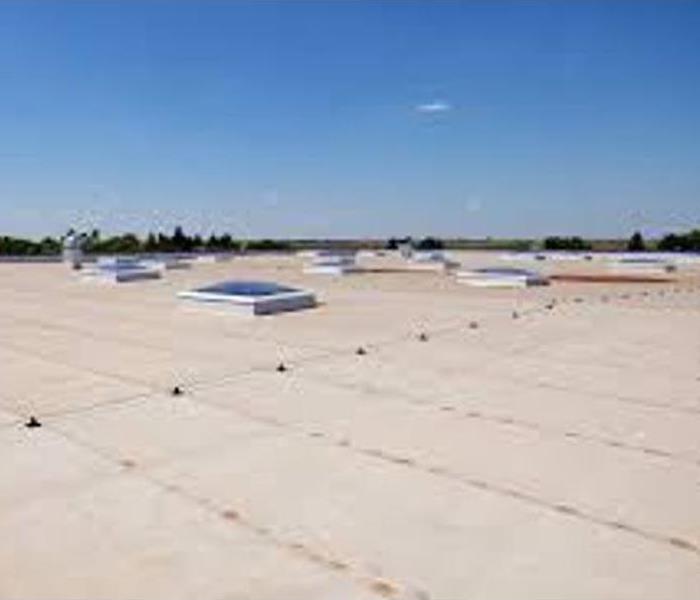 Choosing the right roof for your commercial business can be essential, especially when it prevent water damage and fire prevention.
Choosing the right roof for your commercial business can be essential, especially when it prevent water damage and fire prevention.
You need to choose the material that is best suited to the specific needs for your commercial roof. This process can be challenging. Commercial buildings have properties and designs that are quite different from standard residential properties.
If you are looking for materials for your commercial building, the following tips will help:
1. The current state of your existing structure
The first thing to look at that will help you choose the best material for your situation is the current physical state of your existing commercial roof. You should take into account the roof type, accessibility, protrusions and any structures like fire mitigation systems or HVAC housing. All of these factors will help you decide on the best material for your commercial roof.
Additionally, you can sometimes install a new commercial roof on top of an existing roof. This will save you the cost and time of taking down the existing roof. However, it is not always possible to put one roof directly on top of another.
Furthermore, you should take into consideration existing structures like skylights, vents and AC units. These systems can affect the installation and maintenance process of a different type of commercial roof. Also, you should consider foot traffic as it is likely that people may have to walk on the roof. This will ensure the safety of both your roof and the employees in the building.
2. Its location and climate
The physical location of a building is another important factor in choosing the best materials for your commercial roof. You should take into account the expected extreme weather conditions for that climate, nearby hazards like wildlife or overhanging trees, and local building codes. Different climates may require different types of commercial roofs for a building.
Additionally, a metal roof, because of its durability, may be well-suited for buildings that see a lot of hail and snow. On the other hand, a reflective-type roofing system would be desirable for buildings in a desert climate. This will help in energy efficiency, and Flexion is a good option. EPDM is another material that is good for buildings in climates with both extreme cold and heat.
Furthermore, two buildings in different locations may benefit from the same type of roofing systems for different reasons. TPO’s energy-efficient properties may be beneficial to a building in an urban setting. Likewise, the puncture resistance and tensile strength of TPO make it a good choice for buildings surrounded by trees with very low branches.
3. The type of business
The type of business that the building will be used for is another factor to consider when you want to get the best material for your commercial roof. The heating and cooling needs of a storage warehouse will be vastly different from that of a retail clothing store.
Energy-efficient systems like TPO or Flexion will be a good choice for a retail store where the customers expect a comfortable and moderate temperature. In contrast, EPDM, a less energy-efficient option, will be a good choice of material for warehouse inventories that are not temperature sensitive.
Buildings, housing manufacturers, and restaurants need a roofing system that can accommodate exhaust and ventilation systems. Buildings like this may require PVC, a material that can withstand damage from oils and chemicals. TPO and EPDM would be a poor choice, as they are both roofing materials that can degrade when exposed to these substances.
4. Impact on the environment
Another factor that will help you choose the best material for your commercial roof is the environmental impact it will have. You may want to look at roofing systems whose materials can be recycled when they have outlived their lifespan.
The reflectiveness of the material is another property as well; It could be able to accommodate green features like photovoltaic panels or additional insulation. The green options are more energy-efficient and subsequently, come with a lower utility cost.
5. Your budget
A commercial roof is a significant investment. However, your choice will inevitably be determined by your budget. Nevertheless, a commercial roof is an important investment, and you need to put more than the initial price tag into consideration. This way you will truly understand its value.
Additionally, the true lifetime cost of the commercial roof should also be considered. This may include factors like available warranties, longevity, repairs, and future maintenance.
In many cases, the lifespan of roofing materials that are less expensive is shorter. Such roofing materials would require frequent materials or repairs, which could prove more expensive in the long run.
6. Plan of the building
Different roofing systems have different longevity. This contributes to plans when choosing the best material for your commercial roof. Different commercial roofs can offer lifespans ranging between 10 to 50 years with proper maintenance and care.
Commercial buildings will most likely be around for decades. Most businesses would want a roofing system with a long life expectancy. However, owners of a property may not want to put a commercial roof on when they plan to sell the property soon. Although they know that is a long-lasting investment, they may not want to do it because of the high cost.
What Business Owners Need To Know About Filing Insurance Claims For Burst Water Pipes
4/5/2022 (Permalink)
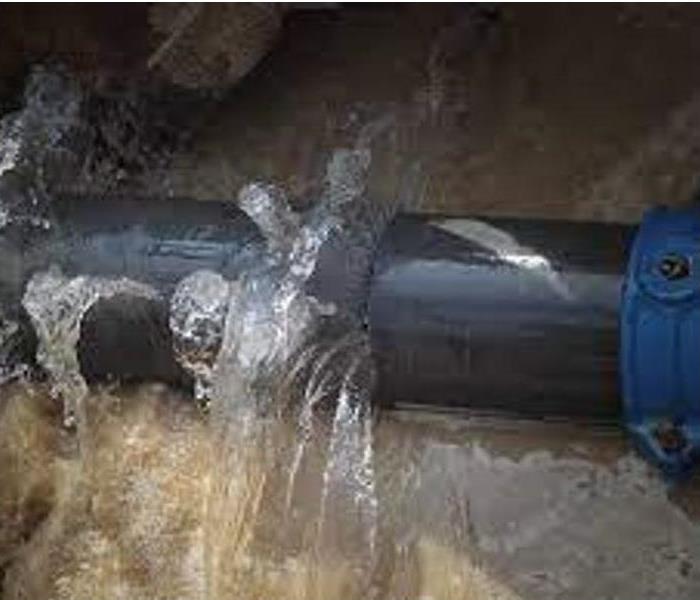 Even if the water is shut off as quickly as possible, a pipe can disgorge several gallons of water into the walls and flooring.
Even if the water is shut off as quickly as possible, a pipe can disgorge several gallons of water into the walls and flooring.
Nothing can bring a business’s operations to a halt faster than the sudden burst of a water pipe. SERVPRO of Kendall County wants to prepare owners for the next steps after these incidents, including how to file a claim that will allow maximum coverage for water damage to a commercial building.
Why are Some Burst Pipe Claims More Costly Than Others?
The costs of water damage restoration can vary widely depending on the extent of the damage. Flooding that is contained to a single room may only require new carpet and pipe repair, while slow leaks can cause damage that goes through several floors—and possibly all the way to the building’s foundation. Even if the water is shut off as quickly as possible, a pipe can disgorge several gallons of water into the walls and flooring, causing partial or total closures until repairs can be made.
Many different factors can affect the extent of damage from a burst pipe, including:
- Business location. The most common cause of water damage from internal plumbing is frozen water pipes. When temperatures drop suddenly, standing water in the pipes expands, cracking the pipe or busting through its seams. Pipes may freeze even in areas where snow and ice is less common in winter, especially if pipes are not properly insulated.
- Building design and construction. The design and layout of the structure can impact both the likelihood and extent of water damage. Common structural factors that lead to burst pipes include unheated attics, failure to adequately insulate pipes between interior and exterior walls, and faulty installation of plumbing systems.
- Sprinkler systems. Fire suppression systems can save lives, but they can also make flooding insurance claims more costly. Water from sprinklers come from larger pipes, has a more forceful water flow, and is sprayed directly from overhead using a wide disbursement system.
- Multi-story buildings. Water will spread across floors, through porous surfaces, and down into the lowest recesses of a building, contaminating everything it touches along the way. If a pipe bursts on the upper floor of a hotel or an apartment complex, owners may have to replace drywall, lighting, flooring, and carpeting in every unit beneath the leak.
- Age. Older buildings increase both risks and costs associated with water damage, since older pipes are more likely to break and may need extensive updates when they do. If a pipe bursts in an older structure, owners will need to pay for any updates needed to bring the building into compliance with current building codes.
UNDERSTANDING COMMERCIAL BUSINESS INTERRUPTION INSURANCE
9/15/2021 (Permalink)
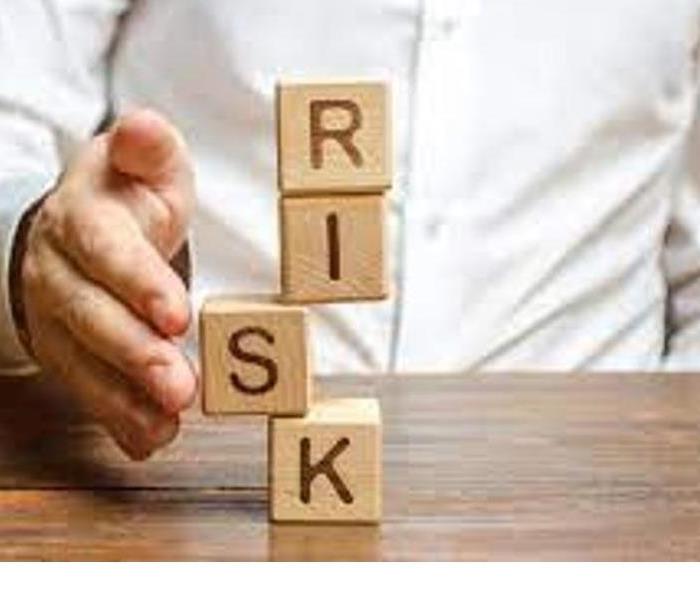 Do I really need business interruption insurance?
Do I really need business interruption insurance?
Do I really need business interruption insurance?
Business interruption insurance is a type of commercial insurance and falls into two categories. There is standard business interruption insurance that covers direct loss, and there is contingency business interruption insurance which deals more with indirect business loss. Both are subject to specific terms and conditions, so be sure to read through your policy thoroughly. The bottom line is important when running a business. We here at SERVPRO of Kendall County know that disaster can strike at anytime, so business interruption insurance can be crucial when deciding your insurance needs.
Business interruption insurance may seem like planning to fail, but any good business owner will tell you to hope for the best and plan for the worst. When assessing your business, it is a good idea to establish what could possibly interrupt your business and what the consequences of that are. Are losses likely to be more direct or indirect? This will help inform you regarding your choice of business interruption insurance. Never assume that it is part of standard commercial insurance. There are several further subcategories of business interruption insurance including, for example, event cancelation insurance. Business interruption insurance can be a complicated beast.
The answer to the original question, do I really need business interruption insurance, is an unequivocal yes. It is essential insurance. No matter what business you are in there is always the chance that there may be physical loss due to unusual weather patterns, freak accidents, or similar.
Steps to Take Immediately Following Water Damage to Commercial Property
9/14/2021 (Permalink)
 Business owners need to know what to do in these scenarios, especially while waiting for the commercial restoration services team to arrive.
Business owners need to know what to do in these scenarios, especially while waiting for the commercial restoration services team to arrive.
Many events could result in serious water damage, but all of them require a prompt commercial cleaning service to set the property right again.
#1 Switch Off the Water Mains
When a property owner discovers water damage, Step One is always to find the source. If the problem is still active, such as a burst pipe or leak, shut down the water source. The company may need to call a professional plumber to control the water or close the water main before continuing.
Water leakage can happen anywhere in a commercial or residential building for various reasons. If the source is not apparent, a professional service may need to help with a diagnostic search through the area.
#2 Confirm the Water Source
If a leaking or a burst pipe is the issue, closing the water source will prevent further issues. If not, Step Two is finding other possible sources of the water damage. Important checks include walls and the roof, where pipes pass through, and various openings could present challenges.
Enlisting a water damage cleanup and restoration professional is crucial when a commercial building has suffered water damage. It can be dangerous with floors weakened by standing or running water, and collapse could result in possible injuries. There are also risks with fiberglass insulation, asbestos, and mold spores.
#3 Call the Insurance Company
Step Three is for the business owner to notify their insurance company about water damage and start a claim. Some commercial property policies may not cover water damage, so it is crucial to ask for details about the building’s policy coverage. Documenting the damage with photographs is also essential.
#4 Contact A Water Damage Restoration Expert like SERVPRO
Step Four is to find reputable commercial restoration services in the area, like SERVPRO of Kendall County.
We have years of experience to cover cleanup, water removal, drying out processes, and tear-out aspects of commercial restoration services in Kendall County. They safely complete dry out and removal tasks, minimizing damage and the risk of exposure. We also offers emergency service and mold remediation as one of the industry’s most reliable fire restoration companies.
Prepare Your Business for Severe Weather in Less Than an Hour
8/24/2021 (Permalink)
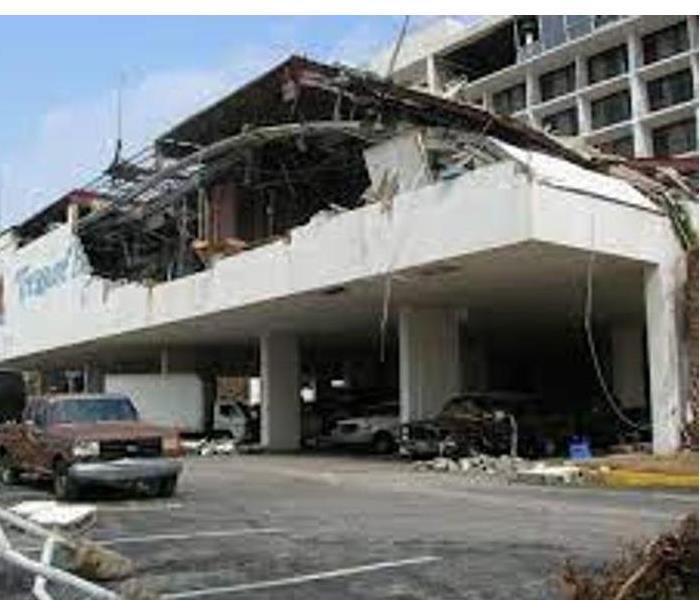 Let’s take a look at the quickest, highest-impact tasks you can tackle when you know severe weather is on the way.
Let’s take a look at the quickest, highest-impact tasks you can tackle when you know severe weather is on the way.
There are several steps you should follow year-round to make sure your business is prepared for rain, wind, and lightning.
Let’s take a look at the quickest, highest-impact tasks you can tackle when you know severe weather is on the way.
Double-check your emergency damage plan
First things first: Know what you’ll do if weather-related damage does strike your business. Your emergency damage plan should outline your building’s insurance coverage, unique risk factors, and SERVPRO of Kendall County's contact information.
Have your emergency survival kit ready
You should always keep an emergency survival kit handy in your business. Be sure to include:
- Drinking water
- Non-perishable food
- Flashlights and extra batteries
- Battery-powered radio
- Standard first aid kit
- Copies of important personal or business documents
Keep your survival kit in an easy-to-find location. By having all of these items easily accessible from the get-go, you’ll be able to devote more of the precious time before the storm rolls into other tasks.
Clean your gutters
Water damage is one of the most common (and most expensive) weather-related problems. It comes in the form of everything from flash floods to mold growth — and it costs business owners thousands of dollars each year.
Many preventable leaks can be staved off with one simple trick: Keep an eye on your gutters!
You should routinely clean your gutters and downspouts at least twice per year. If you have time before a storm hits, though, it’s a good idea to give them an extra sweep. This will make sure your drainage system is working at peak capacity to prevent water from accumulating on your roof.
Lock all windows and doors
Another way to prevent water damage is to make sure all openings to the outside world are properly sealed.
You can do this by:
- Firmly closing and locking your windows
- Securing your doors
- Stuffing towels or other absorbent fabric in any draft spaces
Do a quick outside sweep
When you get word of a severe storm creeping in, head outside and take a lap around your business.
Be on the lookout for any immediate problems you can fix quickly, like:
- Loose planters, personal belongings, or other objects that could turn into flying debris during high winds
- Weak or dead tree branches, especially those near your home or business’s windows
- Cracks in your building’s siding that can be sealed with a can of foam
Stay safe inside, and assess any damage when the storm has cleared
Make sure you are securely indoors before the storm’s rain, wind, and lightning hits. It’s better to leave a few building tasks unfinished if it means you’ll be safe.
Once the weather has cleared, head outside to evaluate the business for any damage. Walk the perimeter of your property and document anything that looks unusual, like:
- Broken glass
- Missing roof shingles
- Damaged window shutters
- Dislodged door or window frames
- Fallen tree branches
- Excess pooling of water
- And more
If you notice any damage, get in touch with SERVPRO of Kendall County right away. We’ll come out to assess the damage, board up any broken windows or doors, and get things back to normal as soon as possible!
YOUR COMMERCIAL PROPERTY HAS WATER DAMAGE: NOW WHAT?
8/14/2021 (Permalink)
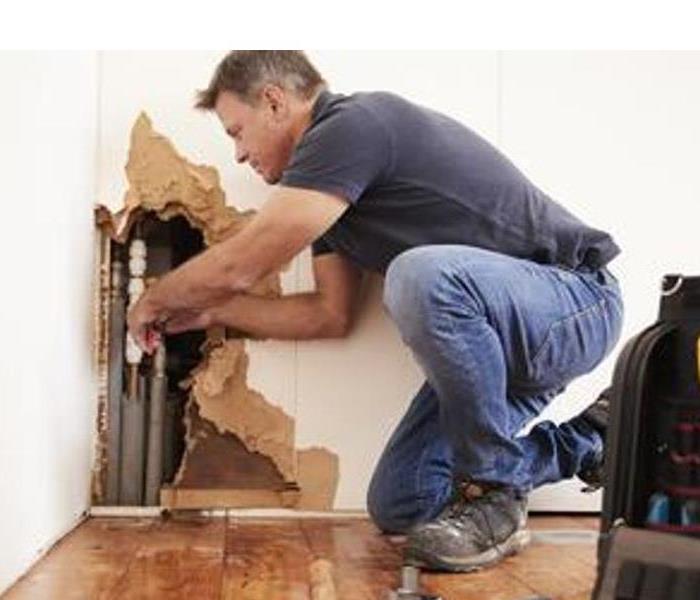 Whether it’s flood water damage or some other form of moisture intrusion, what should you do when the commercial property you’re inspecting has water
Whether it’s flood water damage or some other form of moisture intrusion, what should you do when the commercial property you’re inspecting has water
There are numerous situations where a commercial property might suffer extensive water damage. For example, a flood from a storm or overflowing river bank might deposit massive amounts of dirty water all over the first floor of a structure. Or, a burst/leaky pipe might cause water to collect in the spaces between the walls or floors in the structure, leading to mold growth and other issues in these hidden areas.
Whether it’s flood water damage or some other form of moisture intrusion, what should you do when the commercial property you’re inspecting has water damage?
Confirming the Extent of the Damage
One of the first things you’ll want to do when you discover signs of water damage is verified the extent of the damage. However, a simple visual check probably won’t be enough to reliably establish the full scope of the problem.
Water can soak into many building materials far from the source of the moisture intrusion without creating obvious signs of damage for a long time. So, to accurately establish how far the water has spread, you need a specialized tool for measuring moisture in building materials—such as a moisture meter for building inspection.
Using a moisture meter, you can measure the moisture content (%MC) of the materials near where you noticed the water damage. By continuing to make checks progressively farther from the site of the damage, you can establish how widespread the damage is as well as the severity of the moisture intrusion.
With this information, you’ll be able to determine whether you need to focus on drying out the affected materials, or simply tear them out so they can be replaced with undamaged materials.
Contacting a Water Damage Restoration Expert
If you’re inspecting your own property and do not have experience in water cleanup/restoration work, it may be a good idea to contact a water damage restoration expert, such as SERVPRO of Kendall County to handle the task of dry-out/tear-out for you. This is because water damage remediation work can be too delicate or dangerous for someone without specialized experience or training to risk.
For example, a professional in water damage restoration is likely to have the right tools and experience to minimize their risks from hazards such as mold spores, exposure to fiberglass insulation, and weakened floors that may collapse—all of which are common hazards in water cleanup and restoration work. Additionally, an expert is more likely to be able to successfully complete dry-out tasks in a way that minimizes the overall damage and risk of future problems.
Drying Out the Affected Area
If the structure has a climate control system, then turning up the temperature slightly can help to keep water from condensing—allowing dry-out work to proceed just a bit faster.
When drying out a room in a building with flood damage, it’s important to keep the building as sealed against exposure to the outside air as possible. Otherwise, mold spores and other contaminants can make their way inside and, with the help of the excess moisture in the structure, begin to proliferate. Any air movers attached to an opening should be sealed in place in such a way that they constantly force air out and prevent outside air from getting inside.
Any moisture-compromised furniture should be removed and assessed. If it is too water-damaged, it will need to be thrown out and replaced. The same goes for any building materials in the affected area.
Document Everything!
While you’re busy inspecting and trying to repair the damage to your commercial property, be sure to document as much as possible about the damage, its cause, and the steps needed to fix it. It’s good to do this because you may need to file an insurance claim for the cost of the repairs, and doing so without documentation could result in the claim being denied.
Additionally, taking photographs of the damage can help to further establish proof of the water damage.
If materials or furniture pieces have to be thrown out, keep track of what is being disposed of as well. This may prove useful for determining the extent of your losses for the insurance claim. A water damage restoration expert will likely recommend that you collect thorough documentation as well since it helps them get paid by the insurance company.
This, of course, assumes that you have an insurance policy on the commercial property that covers the costs of water damage. If your property doesn’t have such insurance, then the costs will have to come out of your pocket.
These are just some of the basic actions to take if your commercial property suffers water damage. While contacting a water damage restoration specialist is probably the best thing to do, following these simple steps should help you mitigate the damage somewhat. As a basic rule of thumb, if the damage is severe enough to warrant filing an insurance claim, then you should probably hire an expert in water damage cleanup.
Office Disinfection Services
8/10/2021 (Permalink)
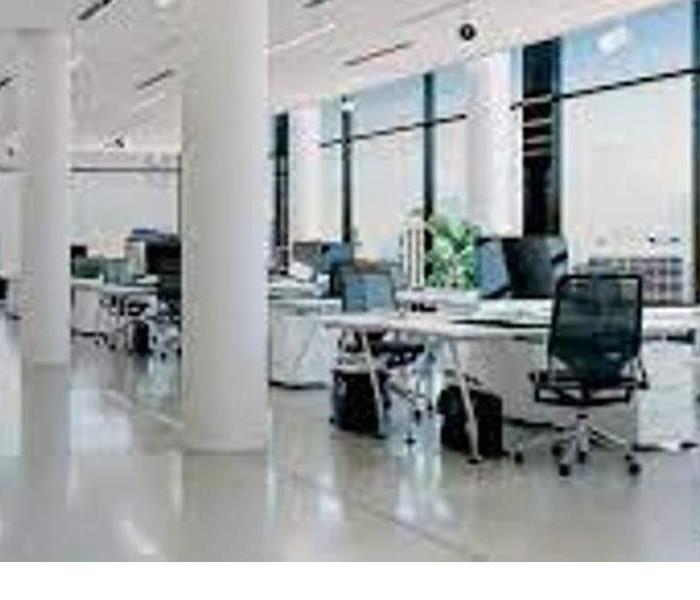 There are many points that make commercial disinfection services different from a traditional cleaning process.
There are many points that make commercial disinfection services different from a traditional cleaning process.
A commercial cleaning service can be useful, but it won’t get your property all the way clean like what you’d get from a commercial disinfection service. There are many points that make commercial disinfection services different from a traditional cleaning process. You’ll see that disinfection provides a more protected environment secure from various threatening bacteria and viruses.
Our work at SERVPRO of Kendall County will ensure your property receives the disinfection support it needs. We provide a more thorough approach to cleaning than what you would get elsewhere.
Unique Cleaning Items
Disinfectants have taken center stage for how they target viruses and other compounds. Disinfectants can be certified by the CDC and other organizations to ensure dangerous viruses can die off during the cleaning effort.
Traditional cleaners can break up visible stains and other items and clear them off a spot. They can produce a comfortable space, but they may not be as effective as a disinfectant.
Working a Little Longer
The disinfection process takes extra bits of time to complete. It can utilize an antimicrobial solution that sticks in an area for a predetermined dwell time. The goal is to achieve the ideal kill rate against bacteria and viruses. The disinfection effort works with more support than a traditional cleaning effort that entails applying a cleaner and then washing it off not long afterward.
Disinfectants work differently from traditional cleaners that only break apart surface stains. You can use a cleaner if you need to produce a spotless environment in less time, but it won’t go all the way in protecting your space as a disinfectant can.
Focusing on Small Spaces
Traditional cleaning work involves cleaning large spaces, including carpets, walls, counters, and various high-touch items. Disinfection involves going into some of the smallest spots in a property, including the doorknobs, handles, buttons, switches, and other things people contact each day. Disinfection is about targeting the items that people will touch throughout the day, as they are the spots with the highest viral loads.
Avoiding Zone Cleaning
Many cleaning projects entail zone cleaning processes. Zone cleaning entails a building is divided into zones. One cleaner is assigned to each zone. There might be one cleaner for a specific room or another for a different floor.
While zone cleaning sounds convenient, it can result in duplicated efforts. The results may be inconsistent, as one place may be cleaned better than others. Commercial disinfection services focus on the same process throughout an entire building, including using the proper cleaning items through each space in the building.
Be sure to note how well our commercial disinfection services at SERVPRO of Kendall County can work, and note that these are different from regular cleaning efforts. You might not visibly notice the effects of a disinfection process, but you’ll feel comfortable knowing that the bacteria and viruses you don’t notice each day are being cleared out of your building before they can cause anyone to become ill.
Fire Extinguisher Cleanup
7/27/2021 (Permalink)
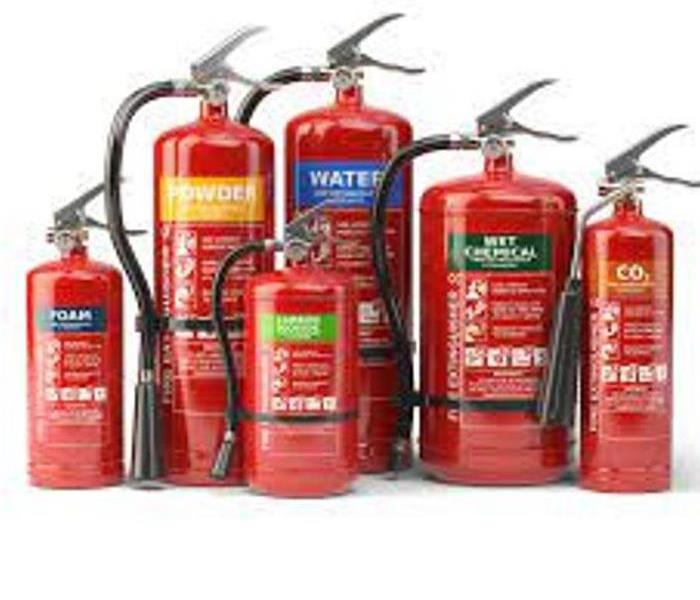 Are all fire extinguishers created equal?
Are all fire extinguishers created equal?
Are all fire extinguishers created equal? The answer is no. Fire extinguishers are similar to cars. There are many different makes and models that differ in design, quality, durability, serviceability, and function. However, they all have one common purpose: to quickly and effectively stop a fire from spreading.
The different types of fire extinguishers have specific requirements for cleaning the extinguishing agent after discharge. Below we’ve identified a few types of fire extinguishers and how to properly dispose of any residue left behind.
DIFFERENT TYPES OF EXTINGUISHERS INCLUDE:
- Dry Chemical Fire Extinguisher – Compact and portable designs make these extinguishers best qualified for the protection of minor hazards in industrial and commercial settings.
- Wet Chemical Fire Extinguisher – By incorporating a flexible design and effective liquid agent, this extinguishing system quickly reduces flames and cools hot surfaces specifically in foodservice kitchens.
- Clean Agent Fire Extinguisher – This extinguisher is commonly used in areas with sensitive computer equipment (e.g. server rooms) because the discharge dissipates into the atmosphere.
- Class K Fire Extinguisher – With the ability to hold in vapor and steam from a fire, this extinguisher is used in commercial kitchens for grease fires.
CLEAN-UP RECOMMENDATIONS
While fire extinguisher discharge does not usually present health hazards, the experts at State Systems want you to be prepared. That being said, do you know how to properly clean up the leftover residue after your fire extinguisher is put to use?
DRY CHEMICAL FIRE EXTINGUISHER
- Sweep or vacuum any residue that has settled on the affected area.
- To break down the silicone in the dry chemical, spray the affected area with a solution of 50% isopropyl alcohol and 50% warm water. Allow the solution to penetrate the residue for a few minutes, then rinse with warm water.
- To neutralize sodium bicarbonate and potassium bicarbonate-based dry chemicals, wash the affected area with a solution of 98% hot water and 2% vinegar. Allow the solution to sit for a few minutes; then rinse with warm water.
- To neutralize mono ammonium phosphate-based dry chemical, wash the affected area with a solution of hot water and baking soda. Allow the solution to treat the excess agent for a few minutes, then rinse with warm water.
- Wash the area with a mild soap and water solution; then rinse.
- Blow the area dry to remove excess water.
WET CHEMICAL FIRE EXTINGUISHER
- Confirm all fuel sources to the equipment have been shut off.
- Make sure to wear rubber gloves. If the liquid or fire extinguishing agent comes into contact with your skin or eyes, flush thoroughly with water.
- Use hot, soapy water and a cloth or sponge to wipe away the foamy residue. Scrub all surfaces that have come into contact with the excess agent.
- Once all surfaces impacted with the residue are cleaned, rinse and allow time to dry before returning power back to the equipment.
CLEAN AGENT FIRE EXTINGUISHER
No special precautions need to be taken after the fire extinguisher is used.
CLASS K FIRE EXTINGUISHER
Rinse the affected area with a solution of soap and water.
ADDITIONAL CLEANING TIPS
- Items such as artwork, tapestries, and electrical equipment need to be professionally cleaned to avoid further damage.
- Be extra cautious when treating cooking equipment and food storage during the cleanup process.
- Immediately recharge or replace your fire extinguisher
Tips for preventing water damage at your business
4/6/2021 (Permalink)
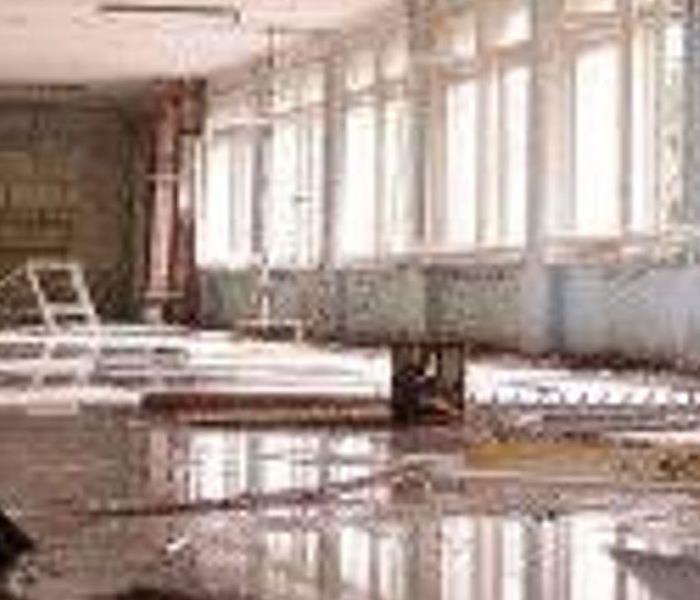 Proactive Tips for Preventing Water Damage to Your Business
Proactive Tips for Preventing Water Damage to Your Business
1. Insulate exposed pipes
When temperatures drop during the winter, especially at night, exposed pipes are vulnerable to freezing. Plummeting temperatures or cold drafts can freeze water inside a poorly insulated pipe, creating pressure and ultimately causing the pipe to burst. A broken pipe can lead to costly flooding or even structural damage.
The best way to prevent frozen pipes is to ensure they’re insulated. Most hardware stores carry pipe insulation. The more insulation you use, the better protected your pipes will be.
2. Keep heat at sufficient levels
To prevent pipes from freezing, you’ll want to keep an eye on your business’s thermostat. Make sure the thermostat is never set lower than 50 degrees – even on weekends or when the building is vacant. Avoid significant changes between nighttime and daytime temperatures, which increases the risk of your pipes freezing. In addition, be sure to regularly replace batteries in thermostats to ensure they’re operating correctly.
3. Inspect gutters and drainage
Fallen leaves and other debris in gutters and downspouts can lead to water damage to the exterior and interior walls of a building. Regularly inspect your business’s gutters, downspouts, and drainage system, and remove any debris or buildup. Have gutters professionally cleaned on a regular basis to ensure water is draining properly and away from the building.
4. Clear your roof
Snow and ice accumulation on your business’s roof can result in weakened roofing materials and create “ice dams,” which prevent melted ice and snow from properly draining. Regularly remove snow and ice from your business’s roof to prevent structural damage. Know your roof’s load-bearing capacity, and periodically check to ensure that snow and ice aren’t accumulating beyond its weight limits.
5. Locate your shut-off valve
If a pipe breaks, you’ll need to act quickly. That means you should know the location of the main shut-off valve for your building’s water supply. Shutting off the main valve will temporarily cut the flow of water to the building, preventing flooding until you are able to fix the problem.
6. Seal cracks and gaps
Seal any cracks, holes, or other gaps in your building’s exterior and foundation to ensure that cold air doesn’t penetrate your building and warm air doesn’t escape. Caulk, weather stripping, and other sealants can be used to make your building more energy-efficient and reduce the risk of frozen pipes.
Four common causes of water damage in commercial properties
4/6/2021 (Permalink)
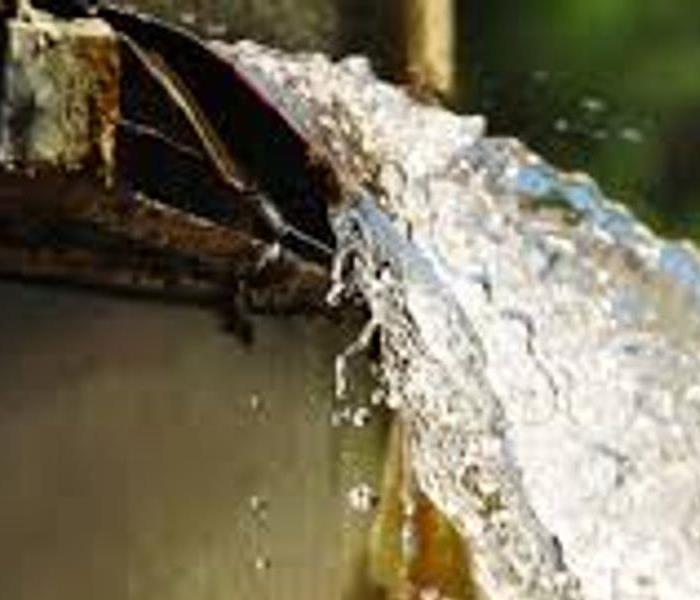 Know-How to Protect Your Business Before Diaster Strikes
Know-How to Protect Your Business Before Diaster Strikes
In this article, we’ll share the four common causes of water damage in commercial properties so that you know what to avoid and how to prevent these problems:
1. ROOF LEAKS
The roof sitting on top of your Kendall County business establishment is meant to protect the building and its occupants inside. But as it is constantly exposed to the harsh outdoor elements, it is subject to wear and tear over the years. When a heavy storm, snowstorm, or hail storm occurs, it can cause damages to the shingles and other roofing components. As a result, your occupants will encounter water leaks coming from the roof that will disrupt business workflow.
2. BROKEN HVAC SYSTEM
It’s common for a commercial building to have Heating, Ventilation, and Air Conditioning (HVAC) systems installed on its property. While the AC unit cools the space and keeps the occupants comfortable during summer, the boiler serves to warm the area during winter instead. However, the problem starts when one heating component of the HVAC system gets broken and starts to leak water. If your unit isn’t regularly maintained and repaired, keep in mind that it can lead to significant water damages.
3. DAMAGED PLUMBING SYSTEM
Apart from the HVAC system, your plumbing system can also have some minor or major issues. As you may be aware, this complex system consists of pipes, valves, fixtures, and fittings, and provides water supply to the entire building. Similarly, this system properly disposes of wastewater used by the occupants. Over the years of usage, it’s inevitable for some parts or components to get damaged. If left unattended and fixed for long periods, they can easily and quickly escalate to water damage that will require costly repairs and replacements.
4. NATURAL CALAMITY
One of the biggest culprits of commercial water damage in Kendall County is a natural calamity. Expect to have some major damages in your business establishment soon after a hail storm, thunderstorm, and heavy rain. Not only do they cause rainwater leaks from the roof and gutter, but they can also lead to floodwater in the basement, crawl spaces, and other parts of the building. This is why preparing for any natural disaster is a must to protect your commercial property!
SHOULD YOU HAVE A COMMERCIAL FIRE SPRINKLER SYSTEM INSTALLED
4/6/2021 (Permalink)
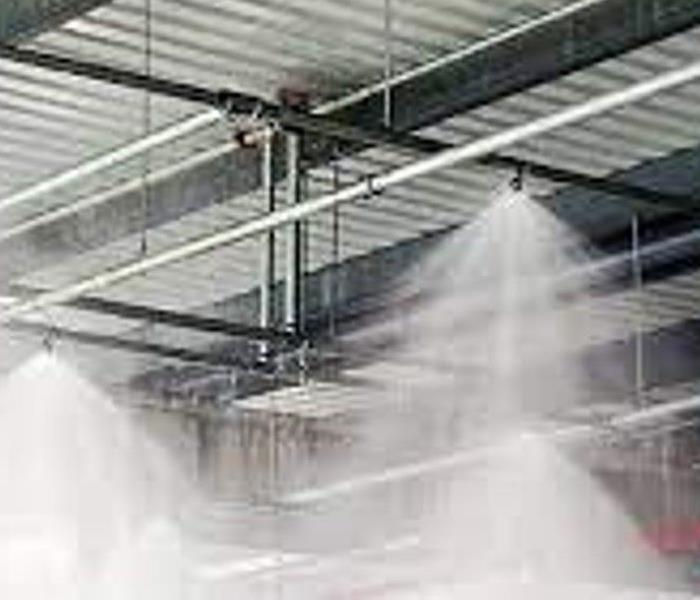 Provide Peace of Mind with a Commercial Sprinkler System
Provide Peace of Mind with a Commercial Sprinkler System
According to the U.S. Fire Administration, there are more than 100,000 non-residential fires every year with many taking place in office buildings, retail stores, restaurants, and other commercial establishments. Don’t have a commercial fire sprinkler system at your business? Now is the time to have one installed. Not only does it protect you, your employees, and your customers but also your business assets in the event of a fire.
A business owner who wouldn’t think twice about the need for insurance may sometimes doubt the need for a commercial fire sprinkler system but both operate on the same principle: you only realize their value when you need them. What are the benefits of fire sprinkler systems? Here are just a few:
HELPS YOUR COMPANY STAY WITHIN THE LIMITS OF THE LAW
If your commercial property is on the smaller side, you may be able to get away without installing a commercial fire sprinkler system. You also may be able to get away with it depending on the location of your business. But generally speaking, most cities and towns throughout the country require business owners to install some kind of fire sprinkler system inside their commercial properties.
ALLOWS YOU TO AVOID EXTENSIVE DAMAGE DURING A FIRE
It’s never a good thing when a fire starts inside a commercial property. Even a small fire can do a lot of damage to an office building, a retail store, or a restaurant. But if a fire does start inside your commercial property, you want it to stay as small as possible. Unrestrained, a fire can spread through a building in a matter of minutes. A commercial fire sprinkler system will stop a fire dead in its tracks. Once the system detects the fire, it immediately goes to work containing the blaze. A commercial sprinkler system stops the fire in its tracks, limiting damage and allowing the fire department to get it under control.
PREVENTS A FIRE FROM CAUSING INJURIES AND DEATHS
A fire inside a commercial property can do more than just cause a lot of property damage. It can also cause injuries and even claim lives if it’s able to spread quicker than people can get out of a building. And it’s smoke inhalation, not the fire, that kills most people. A fire may be on the first floor but the smoke can quickly spread to upper floors causing injury and death.
There’s no guarantee that you’ll be able to prevent all injuries and deaths during a fire in your commercial building but the chances of injuries and deaths are much lower with a commercial fire sprinkler system.
YOU SAVE MONEY ON INSURANCE
Some business owners shy away from installing commercial fire sprinkler systems because they’re under the impression that they’re going to break the bank. They don’t realize that a sprinkler system could save them money in the long run. Once you have a sprinkler system installed in your business, your insurance company will likely lower your rates. As long as you keep your sprinkler system up to date and maintain it, they’ll keep your rates low, too. A sprinkler system means less risk for the insurance company which translates into lower premiums.
SHOWCASES YOUR COMPANY’S COMMITMENT TO SAFETY
You want your employees and your customers to feel like you care about them. You also want them to feel safe when they’re working in or visiting your commercial property. You can accomplish both of these things with a commercial fire sprinkler system. Your sprinkler system will show others that you’re doing everything in your power to ensure the safety of your building.
PROVIDES YOU WITH PEACE OF MIND
As a business owner, you probably have more than enough on your plate right now. You have to juggle everything from payroll to inventory on a regular basis. With a commercial fire sprinkler system, you’ll enjoy peace of mind that you wouldn’t get otherwise. You won’t have to stress out over what might happen to your business when you’re not around. Your sprinkler system will be there looking over it for you.
Protect Your Business From Scary Commercial Water Damage
9/11/2020 (Permalink)
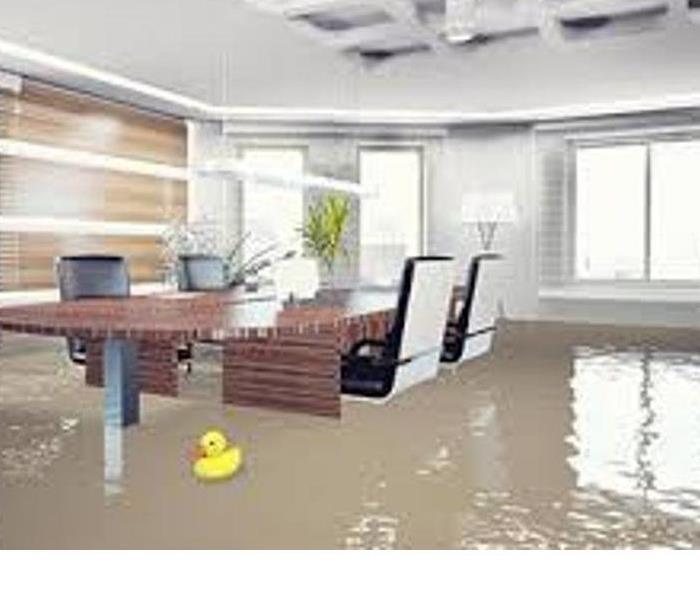 Protect your business from potental water disasters
Protect your business from potental water disasters
Your family depends on your business. So do your employees, as well as your customers and community. So the thought of commercial water damage caused by extreme weather or plumbing failure is scary. But you don’t have to be scared. A little planning and a few precautions will help you breathe a little easier, knowing you’re ready for any commercial water damage contingency,
Commercial Water Damage Tip: Think it Through
Start by asking yourself, “What if?”
That’s a powerful question when it comes to reducing commercial water damage risk. For instance, what if a water main bursts and floods your office? This always leads to more questions, such as how will you ensure the safety of your employees and customers? Or how will you prevent or eliminate business disruptions that might result in cash flow problems? How will you communicate with employees during emergencies or periods of disruption (say, when a pipe bursts and requires the main power to be shut off during repairs)? Make notes of your answers to all your questions, because organizing this information is the basis for the next key step in preventing and minimizing commercial water damage: making a plan.
Commercial Water Damage Tip: Make a Plan
While thinking through possible commercial water damage scenarios for your business, you made notes of the solutions you came up with for your “what if?” questions. Now put your thinking into action to craft an emergency plan for your business. A good emergency plan should provide for the safety of all people who could enter your business, as well as set forth processes and procedures for carrying on with business during a variety of challenges.
It should include, at the very least:
- an emergency contact list (accessible from off-site)
- emergency procedures
- emergency staffing instructions
- vendor lists and contact info
- data backup plans and other resources to support business operations in case you have to temporarily or permanently relocate your business operations.
You should note that this plan is never finished. You should always be updating and improving it with lessons you learn during any business disruption.
Commercial Water Damage Tip: Inspect, Repair, Repeat
Stuff gets old. It breaks. It fails. When plumbing or water-management equipment in your commercial facility fails, the resulting water damage restoration costs can stack up fast. So the operative word for commercial water damage prevention is maintenance.
Routinely inspect all visible plumbing, test basement sump pumps, check exterior gutters and downspouts, muck out drainage ditches and storm drains, and ensure roof structures are in good repair. Commercial property managers generally agree that a water leak on a commercial property is the most costly problem you can have, often costing thousands of dollars to mitigate, once the problem develops. Good property maintenance can lop off a big chunk of commercial water damage risk, so don’t cut corners on repairs.
Smoke Alone Can Do a lot of Damage To Your Business
9/11/2020 (Permalink)
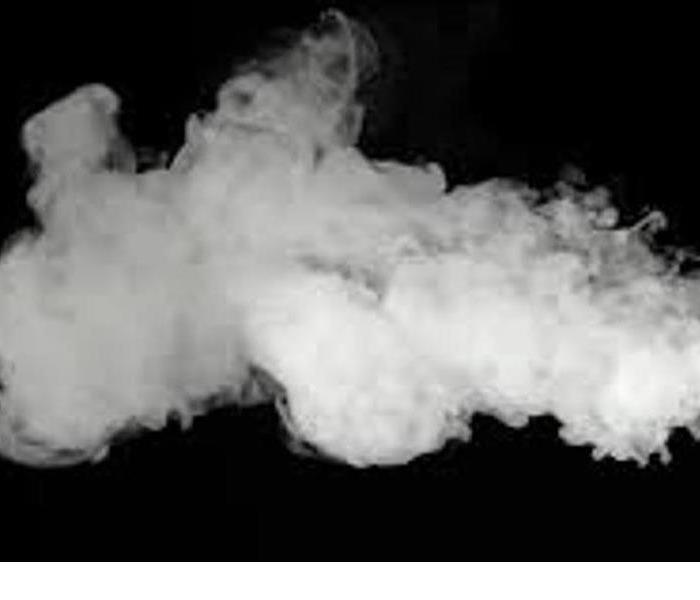 Smoke damage can happen throughout your business when there's a fire.
Smoke damage can happen throughout your business when there's a fire.
Fire, smoke, and soot can affect anything in your business or home, from the structure to personal belongings. After a fire, contacting a cleaning professional may be the best decision you can make.
Smoke and soot facts:
- Hot smoke migrates to cooler areas and upper levels of a structure.
- Smoke flows around plumbing systems, seeping through the holes used by pipes to go from floor to floor.
- The type of smoke may greatly affect the restoration process.
Different Types of Smoke:
There are two different types of smoke–wet and dry. As a result, there are different types of soot residue after a fire.
- Wet Smoke – Plastic and Rubber
- Low heat, smoldering, pungent odor, sticky, smeary. Smoke webs can be more difficult to clean.
Dry Smoke – Paper and Wood - Fast burning, high temperatures, heat rises therefore smoke rises.
- Protein Fire Residue – Produced by evaporation of material rather than from a fire
Virtually invisible, discolors paints and varnishes, extreme foul odor.
Since each smoke and fire damage situation is a little different, each one requires a unique solution. We have the equipment, expertise, and experience to restore your fire and smoke damage.
How to protect your business from wind and hail damage
8/12/2020 (Permalink)
 Protect your Business from Storm Damage
Protect your Business from Storm Damage
Strong winds and hailstorms can cause heavy damage in very little time to a business’s property, resulting in costly repairs and potentially a lengthy business disruption. Beyond the typical structural damage from a storm, gale-force winds can push trees or projectiles onto buildings, and hail can shatter windows and damage your exterior.
Ensuring you have adequate insurance in place will help your business recover in the aftermath of a storm. But it’s also essential that you take steps to protect your property before a severe weather event. From regularly inspecting your roof to securing equipment and valuables, the following actions will help you reduce the risk of damage to your business in the event of a storm.
1. Inspect your roof
Examine your building’s roof for damage after storms, or annually in regions that are less prone to storms. Replace any worn materials or other weak areas to ensure that leaks don’t occur during future storms. Check flashing (a type of sheet metal used for waterproofing) and gutters, and clean out any debris that may be blocking drainage. Remove branches or leaves that may have accumulated during prior storms.
2. Install impact-resistant windows
Impact-resistant glass has been specially treated to help prevent shattering and to provide an extra barrier to safeguard your building from severe weather. While it’s still possible for it to break, it’s less likely to shatter completely, offering better protection from flying glass and debris during a hurricane or hailstorm.
3. Secure equipment and valuables
If you live in an area prone to strong winds or hail, keep an eye on the weather forecast so that you can protect your valuables before a storm hits. Ensure any high-value items are in a safe and secure area, stored up high and away from windows. Any outdoor equipment should be securely fastened so it’s not lost or turned into a projectile during a storm.
4. Keep your employees safe
In the event of a storm, safety is of the utmost concern. Stay away from windows, and take shelter in the safest part of your property. If your building doesn’t have a designated storm shelter, have employees take shelter in an area devoid of windows, such as a bathroom or break room.
Prepare an emergency plan ahead of time and communicate it with employees, so they’ll know what to expect. Practice an emergency drill if possible, so that everyone will be prepared if weather conditions are threatening your safety.
Determining Proper Business Insurance Coverage
8/12/2020 (Permalink)
 Getting the Correct Business Insurance is Essential
Getting the Correct Business Insurance is Essential
How do I determine the proper cover and limits for my business insurance?Figuring out what coverage to have in place and what limits are needed is a real balancing act. On one hand, proper insurance is necessary to reduce the risk of owning and operating a business. On the other hand, unaffordable and unrealistic premiums are also not in your best interest as a business owner.
If your business is like most small businesses, you probably don’t have a full-time risk manager to answer your business liability insurance or workers’ compensation insurance questions. So where to start?
It may make sense to focus your research on three common types of small business insurance coverage: general liability, property and workers’ compensation insurance. Once you know what questions to ask, it’s much easier to select optimal small-business insurance coverage and business liability insurance rates. It’s also important to understand that business liability insurance rates will vary depending on your business’s needs.
Property and Casualty insurance covers building and property against damage, theft, and other causes such as fire. The contents and furnishing as well as most inventories are covered. It’s important to determine rebuilding costs, restocking costs, and relocation costs if the incident could require it.
Comprehensive general liability insurance coverage protects you in the event of claims of bodily injury or physical injury or damage to property. This includes legal defense and settlements up to the limits of the policy. Check with your industry association and state department of insurance to determine types of claims and what settlements are awarded. In addition, professional liability insurance may be needed.
Again, both industry and the state department of insurance can help in determining the proper limits.
Workman’s compensation limits and minimum coverage are generally determined by your industry and state.
The key is to work with a licensed insurance professional you trust to develop a comprehensive insurance package for your business. Eligible businesses can purchase property insurance packaged together with general business liability insurance coverage in a single policy called a Business Owner’s Policy, or BOP.
Such combined policies are generally available at reasonable small-business rates. Your licensed insurance professional may make this recommendation to you.
Protect Your Business Against Water Damage
8/10/2020 (Permalink)
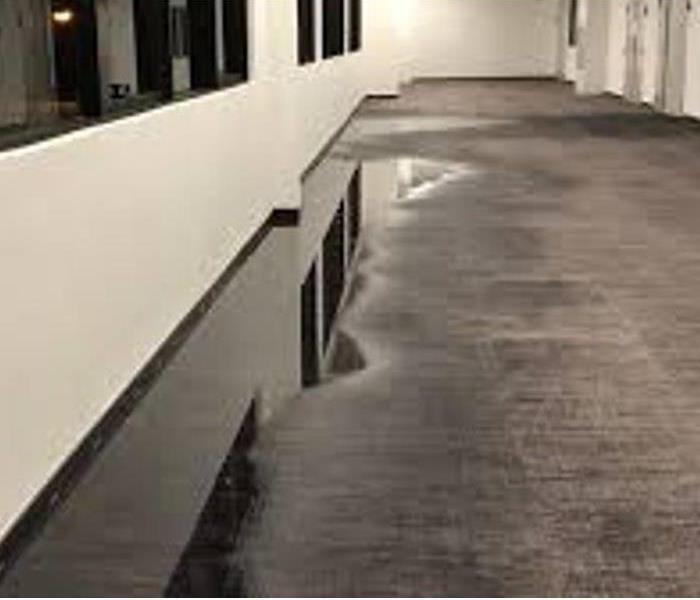 Water damage in a commercial building.
Water damage in a commercial building.
Businesses often protect themselves against smoke and fire damage by installing and maintaining smoke detectors and fire suppression systems. What many businesses don’t protect against is water damage. In fact, properties are 10 times more likely to suffer from water damage than they are from fire damage.
Water damage can come from a variety of sources, and while not all of them may be applicable in every situation, businesses should nonetheless have some sort of water detection as part of their business continuity plan.
Flood monitoring
Floods are the number one natural disaster here in the United States, and statistics show that floods and extreme weather events heavily affect the US.
Many businesses that aren’t located near large bodies of water tend to forget about flood damage, however, it’s important to remember that water damage from flooding isn’t restricted to just those in coastal areas. Overflowing rivers, extreme precipitation, water main breaks, internal plumbing failures and even melting snow can all cause water damage from flooding.
Unfortunately, sewer backup can cause flood damage as well. Sometimes this can be due to extreme weather situations where water damage can be anticipated, and sometimes it can be caused by local construction, decaying public infrastructure, or even tree roots. Having flood/water sensors in basements and below-ground areas can help warn and protect businesses against water damage from sewer backup as well as naturally occurring flood conditions.
Leak detection
Undetected leaks can cause just as much damage as a storm or flood. Leaks can come from a wide variety of sources, including:
- Leaky pipes
- Frozen pipes
- Leaky roofs
- Damaged windows
- Building foundation
- Malfunctioning sump pumps
- HVAC problems
Leaks aren’t always visible immediately, and can cause severe damage the longer they’re not detected. Even a small amount of water can promote unhealthy mold and mildew growth in the right conditions.
Leak detection can come in many forms, including spot sensors as well as cable-style sensors that can be placed on the boundaries of a room or facility. Leak detection can even come in the form of humidity monitoring; the more humid a facility becomes over a short period of time, the more likely it is due to undetected water.
Easily avoid water damage
Setting up proactive water and leak detection can help notify you immediately if the water is detected anywhere in your building or facility. While you can’t stop a storm from occurring or a pipe in your building from leaking, you can stop that damage from becoming too expensive by monitoring for water.
If your business is monitoring for smoke and fire as part of your business continuity plan, be sure to add water and leak detection as well. Helping to keep your facility and assets protected will help you avoid costly repairs and downtime over the long run.
THE CAUSES OF COMMERCIAL WATER DAMAGE AND HOW TO DEAL WITH THEM IN KENDALL COUNTY
7/28/2020 (Permalink)
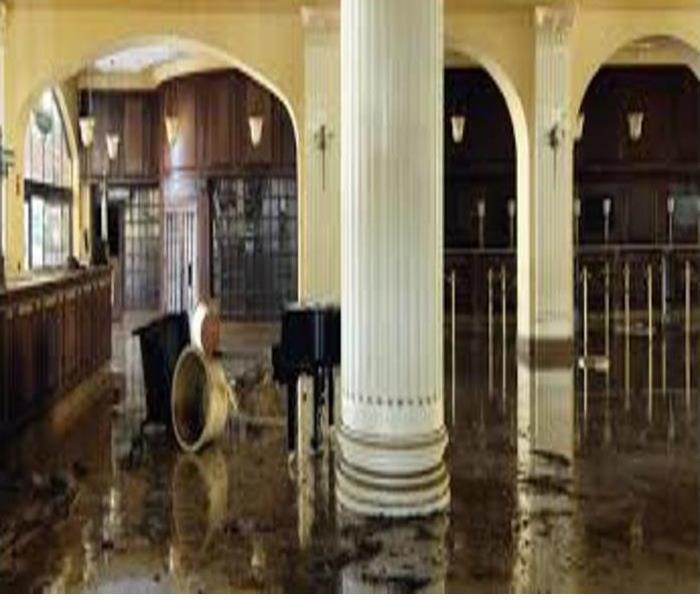 Commercial Water Damage. Don't let this happen!!
Commercial Water Damage. Don't let this happen!!
Water damage in the workplace may not only prevent you from doing business. It can also put the health and safety of your employees at risk. The moment you spot signs of commercial water damage, it’s important to take action immediately. SERVPRO of Kendall County can help with any signs of water damage.
Commercial water damage is often more complex than residential water damage restoration and usually requires a more intensive approach. The size and structure of commercial buildings, the extent of damage, the varying uses of space, and the number of occupants all affect the restoration process. Aside from these, there’s usually always a time constraint for the job because business has to continue as soon as possible.
While some water damage issues are inevitable, most problems can be prevented when the cause of water damage is found earlier.
In this post, we’ll talk about the most common causes of water damage in commercial properties and how to deal with them.
CAUSES OF COMMERCIAL WATER DAMAGE
Here are the common causes of commercial water damage:
DAMAGED WINDOWS
In commercial buildings, water damage is often caused by windows that are not properly sealed. Damaged windows can cause moisture to seep in, which triggers a lot of problems including mold build-up and warped wood and drywall. Resealing windows regularly is important as caulk can break down over time.
DAMAGED PIPES
Broken pipes can stem from a variety of reasons, such as changes in pressure, deteriorated water supply lines and sewer drains, and cold weather (freezing temperature can cause pipes to burst). Bulging walls, water stains on walls or floors, cracked or loose tiles, and musty smell – these are all signs of damaged pipes. Detecting leaky pipes is challenging and it usually requires some specialized water leak detection equipment.
BUILDING FOUNDATION
If gutters are not cleaned regularly, they can get clogged, causing water to leak into the property through the roof or the foundation. One of the most common signs of leaks in building foundations are puddles nearby or framing that has become wet. Poor drainage systems can also lead to water damage in your foundation.
ROOF LEAKS
A leaky roof can cause ceiling damage, mold or mildew issues, fire hazards from shortened wires, and compromised structural integrity. Exposure to heavy rains and snow make roofs vulnerable to damage. Also, incorrect snow/ice removal can also trigger water damage in roofs.
HVAC PROBLEMS
HVAC systems work by heating or cooling the air through a series of ducts. Over time, these ducts wear out and get damaged, resulting in leaks. The HVAC needs to be cleaned regularly and the excess water from the condensation reservoirs has to be removed to prevent water damage. SERVPRO of Kendall County can help with the cleaning of air ducts on a regular basis.
SEWER CLOGS
Sewer water contains bacteria and other pathogens that cause illnesses and infections. If you see signs of sewage damage, such as gurgling sounds or water backing up out of the drain or toilet, you should call SERVPRO of Kendall County right away.
SPRINKLER SYSTEM LEAKS
Other causes of water damage in commercial buildings are leaks in sprinkler systems. Signs of sprinkler leaks include wet surfaces like drywall and carpets, presence of mold and mildew, and standing water. Regularly inspect your sprinkler systems for leaks and moisture.
All of these are helpful tips to keep your commercial property form encountering water damage. If you see any signs of water damage don't hesitate to call SERVPRO of Kendall County.
Commercial Flood Preparedness
5/18/2018 (Permalink)
The weather has been very unpredictable the past few weeks in our area. We have experience heavy rains in a short period of time causing the sewer systems to back up and streets to flood.
If you see there is a flash flood watch, this means that a flash flood is possible. A flash flood warning means that a flood is about to happen or already taking place. If a flash flood occurs, you should make sure everyone gets to higher ground as quickly as possible.
Your business can prepare for any potential disaster, including flash floods. Keep all essential equipment and documents elevated from the floor. Ideally, they should be stored on the second floor of the building or higher. Back-up electronic data daily to cloud storage or to an external drive so the files can still be accessed in the event of a disaster.
It is a good idea to have a battery-powered radio available on-site or even some sand bags to help with water absorption. In case of a power outage, you and your staff can keep updated on the current conditions. (FEMA) The Federal Emergency Management Agency provides a list of recommended sites in the event of a disaster, such as a flashlight and first aid kit.
You can also check with the National Weather Service to get more tips on safety during flooding.
SERVPRO of Kendall County can help your business get back on track after flooding or other disasters. Call us today for more information or a free inspection 630-554-2280
Commercial Business Ready
5/18/2018 (Permalink)
Commercial Property owners and Property Managers are entrusted with keeping their businesses operational. When Disaster Strikes, SERVPRO of Kendall County is here to help make it “Like it never even happened.” Facilities Managers rely on us to be ready for Whatever Happens.
General Adjusters and Consulting firms from around the Chicago land area trust SERVPRO of Kendall County with their most complex claims. Some of our specialties include
- Small Office Buildings
- Large Office/High-Rise Office Buildings
- Apartment Buildings
- Restaurants
- Hotel/Motels
- Commercial Reconstruction
- Small Retail Stores
- Large Retail/Big-Box Stores
- High-Rise Residential
- Manufacturing & Industrial
- Government/Military
- Universities
- Schools
- Restaurants
- Commercial Disaster Recovery Services
- We are available around the clock to get your business back up and running. Our expertise includes restoration services for fire and water damage, including electronics restoration and document drying. We are also your business’s best resource for mold remediation. Learn more about our commercial restoration services by calling SERVPRO of Kendall County at 630-554-2280.
Commercial Fire Loss
5/9/2018 (Permalink)
Fire, smoke, and soot will affect everything in your business or home, from the structure to personal belongings. After a fire, contacting a cleaning professional may be the best decision you can make.
Smoke and soot facts:
Hot smoke migrates to cooler areas and upper levels of a structure.
Smoke flows around plumbing systems, seeping through the holes used by pipes to go from floor to floor.
The type of smoke may greatly affect the restoration process.
Different Types of Smoke
There are two different types of smoke–wet and dry. As a result, there are different types of soot residue after a fire.
Wet Smoke – Plastic and Rubber
Low heat, smoldering, pungent odor, sticky, smeary. Smoke webs can be more difficult to clean.
Dry Smoke – Paper and Wood
Fast burning, high temperatures, heat rises therefore smoke rises.
Protein Fire Residue – Produced by evaporation of material rather than from a fire
Virtually invisible, discolors paints and varnishes, extreme foul odor.
Since each smoke and fire damage situation is a little different, each one requires a unique solution. We have the equipment, expertise, and experience to restore your fire and smoke damage.
Commercial Water Mitigation
5/8/2018 (Permalink)
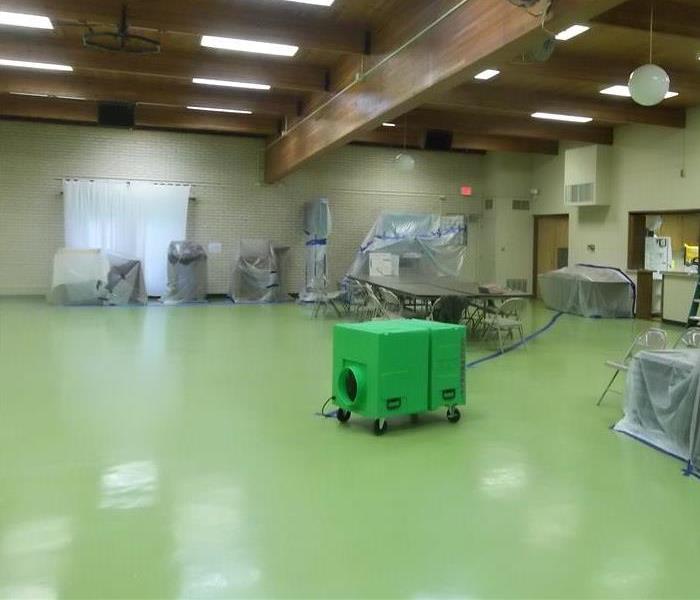
When business owners visualize water damage, they often picture a massive storm wiping out power lines, flooding offices, and shutting down businesses for days at a time. It is true that commercial water damage is often the result of floods and water that stems from weather events and storms.
However, many business owners forget that storms and severe weather aren't the only causes of floods and water damage. Here are some of the common causes of water damage to commercial buildings.
1. Malfunctioning sprinkler systems..
Some older office and retail buildings still have outdated sprinkler systems that work in conjunction with fire protection systems. While such sprinklers can come in handy during a fire emergency, they can also cause commercial flood damage if they are faulty or in need of replacement. This could easily damage inventory and business assets.
2. Damaged appliances and equipment.
This cause of commercial flood damage is more common in restaurants and catering facilities, as well as any business that have appliances and equipment that make use of water. If the appliance fails and sends water across your building, especially during late hours when no one is around, you may come back to work and face a water emergency.
3. Broken pipes and plumbing.
Just like in a residence, if the plumbing system in your workplace fails water damage could be the result.
4. Backed up sewer lines.
This is another cause of commercial water damage that often catches business owners by surprise. Should the sewer line to your building back up or become damaged, the potential dangers of contaminated Black Water which can cause health effects and ruin products and office furnishings.
Commercial Fire and Water Damage Restoration
4/17/2018 (Permalink)
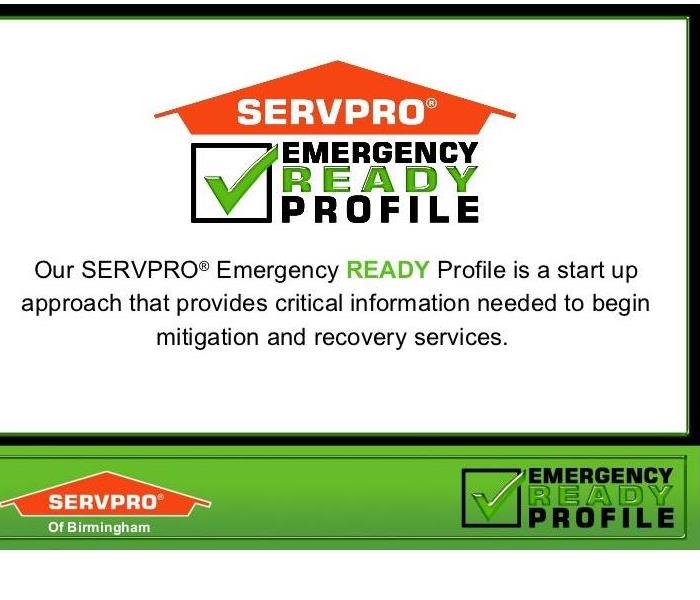 Emergency Ready Profile for your business here in Kendall County
Emergency Ready Profile for your business here in Kendall County
Large Loss Response Team and Disaster Recovery Teams are SERVPRO's elite franchises placed throughout the country to respond Faster to Any Sized Disaster.The best way to reduce business interruption following a disaster is to plan for it NOW.
As many as 50% of businesses may never recover following a disaster, according to the latest industry research. Of the businesses that survive, the overwhelming majority of them had a preparedness plan in place. Pre-planning can serve as an insurance policy aimed at peace of mind.
By developing a SERVPRO® Emergency READY Profile for your business, you minimize business interruption by having an immediate plan of action. Knowing what to do and what to expect in advance is the key to timely mitigation and can help minimize how water and fire damage can affect your business.
Are You Ready?
Preparation is a key component for making it through any size disaster, whether it’s a small water leak, a large fire or an area flood. The best time for planning for such events is not when the event happens, but well before it happens. No one ever plans on a disaster, but you can plan for it. Now is the time to ask yourself, “Are you ready for whatever could happen?”
The SERVPRO® Emergency READY Profile is a start up approach that provides the critical information needed to begin mitigation and recovery services. It is designed to serve as a quick reference of important building and contact information. By working with SERVPRO’s Emergency READY Profile, your business will receive the benefit of over 40 years of experience in reducing the impact of any natural or man-made disaster.
SERVPRO® is a leader in water and fire damage response and can help you quickly get your property back in working order.
The SERVPRO® Emergency READY Profile is a no cost assessment of your facility. It provides:
- A concise Profile Document that contains only the critical information needed in the event of an emergency - a guide to help you get back into your building following a disaster.
- Identification of the line of command for authorizing work to begin. This saves time so we can begin the work of mitigating the damage which can save you time and money.
- Facility details such as shut-off valve locations, priority areas and priority contact information. Having a quick reference of what to do, how to do it and who to call provides solutions in advance of an emergency so that during the emergency you are “Ready for whatever happens.”
At SERVPRO of Kendall County - we are committed to partnering with our commercial clients to reduce business interruption in the event of any type of disaster. To this end - we also work very closely with the Red Cross - leveraging their resources and capabilities to supplement our own when disaster strikes.
Call us at 630-554-2280 to get started - it costs you nothing. Not making the call may be VERY costly. You can also visit our Website for more details.
Fire damage at Commercial Building
4/17/2018 (Permalink)
 Commercial cleaning of a Percussion School
Commercial cleaning of a Percussion School
Whether your business is a small retail store or a multi-building campus of buildings, SERVPRO of Kendall County has the expertise and the equipment to handle any fire, water, or mold emergency in Oswego land area.
Commercial Water Damage
Water damage can happen in many ways. In apartment complexes, there could be an overflowing bathtub or toilet that causes damage in the complex. A frozen pipe in a warehouse could burst and cause extensive damage. A burst pipe or a leaking roof in a manufacturing plant can shut down the production line causing huge losses. When any of these events happens, it’s important to call water damage professionals immediately in order to alleviate the damage. When hiring a water damage cleanup company, it’s important to make sure they have the expertise and equipment to such a large job.
Commercial Fire Damage
Even the smallest of fires can result in extensive damage to a building. While the fire itself can be isolated and extinguished quickly, the culprit of most damage after a fire is the smoke. Smoke can get into the duct work and quickly spread throughout the building. With fire and smoke damage, it’s important to hire fire restoration professionals that can quickly restore your business, your warehouse, your facility, or your residential complex.
Commercial Mold Remediation
Mold is the result of a moisture problem that has usually been neglected. This can be the result of a leaky pipe that is hidden behind a wall or in a ceiling. Mold can also grow quickly when there has been water damage from the contaminated water like a broken sewer pipe or flooding from a nearby river or stream. Contaminated water, also known as gray water or black water, can quickly promote mold growth in less than 24 hours. If not treated, it can quickly grow and cause not only property damage but potential health risks among inhabitants.
Commercial Storm Damage Cleanup
Storms can cause all types of damage to a building. They can cause flooding from rising rivers. They cause water leaks from damaged roofs. They can cause fires from lightning strikes. Tornadoes and high winds can break windows, tear down walls, rip off roofs, and in the worst cases they can level the entire building. A professional fire and water restoration company has the equipment, experience, and knowledge to handle any type of storm damage.
Damage to a business can come in many forms. From fire to flooding to water damage to storm damage and everything in between, SERVPRO of Kendall County has the experience, equipment, and expertise to make it like it never happened. Whether you have a small store or a multi-building complex, call the commercial restoration, remediation, and cleaning experts at SERVPRO of Kendall County at 630-554-2280.





 24/7 Emergency Service
24/7 Emergency Service

























